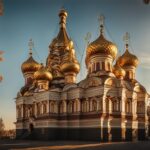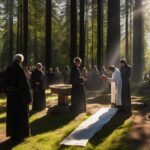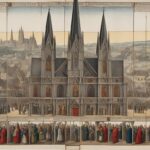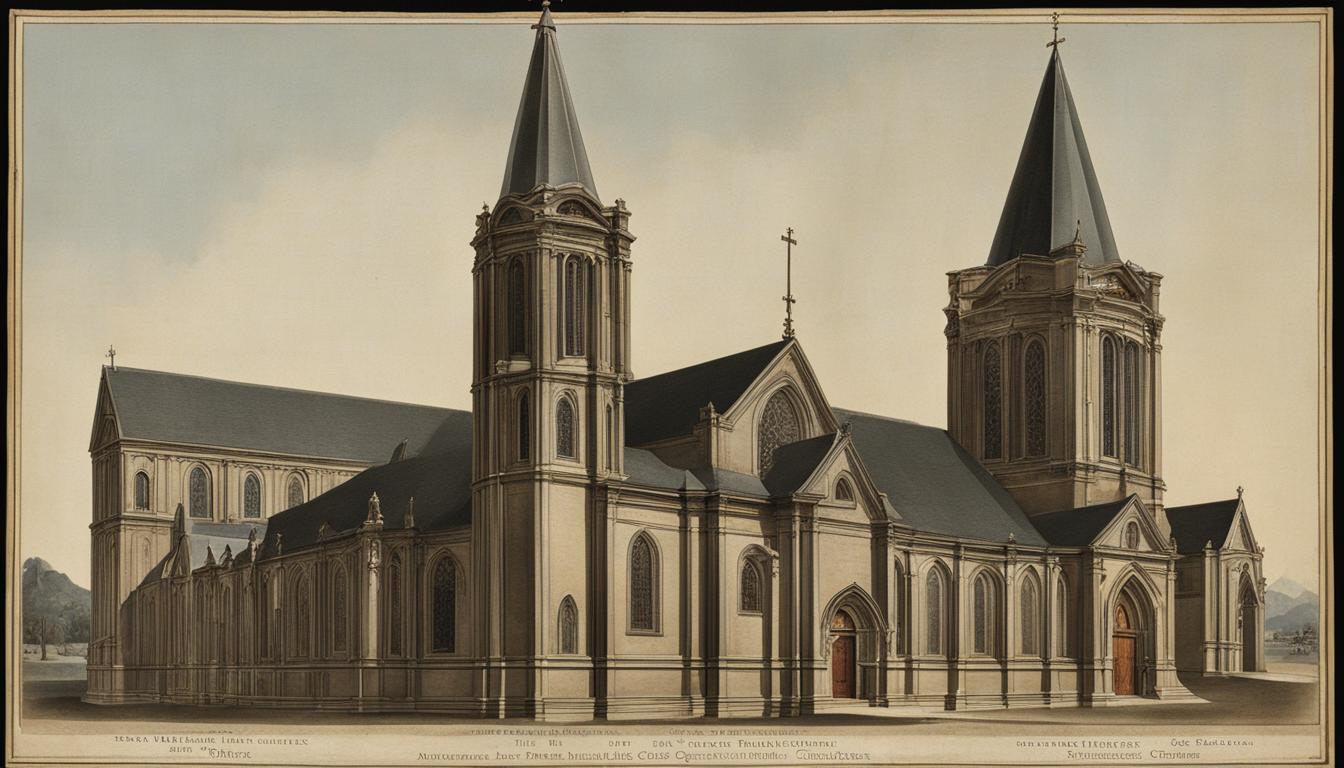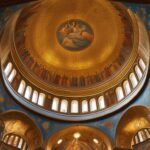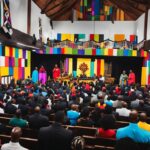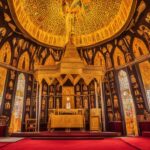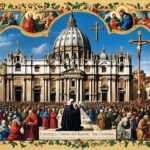The Russian Orthodox Church, also known as the Moscow Patriarchate, has a rich and profound history that spans over a thousand years. It is deeply intertwined with the political, cultural, and spiritual development of Russia. From its origins in the Christianization of Kievan Rus’ to its struggles and triumphs under Mongol rule and the Soviet era, the Russian Orthodox Church has emerged as a resilient and enduring institution.
The history of the Russian Orthodox Church can be traced back to the baptism of Grand Prince Vladimir of Kiev in 988. This event marked the official adoption of Orthodox Christianity by the people of Kievan Rus’ and laid the foundation for the future of the church in Russia. Under Mongol rule, the church enjoyed favored status and protection, which contributed to its growth and influence.
In the 15th century, the Russian Church became effectively independent from the Patriarchate of Constantinople. Moscow saw itself as the Third Rome, with the Metropolitan of Moscow as the head of the Russian Church. The church played a pivotal role in the formation of Russia as a unified and independent state.
Throughout its history, the Russian Orthodox Church has faced challenges and persecution. It weathered the storm of the Soviet era, where many churches were destroyed and clergy members were arrested and executed. However, the church experienced a revival in the late 20th century, reclaiming its spiritual and cultural influence.
Today, the Russian Orthodox Church continues to play a significant role in Russian society, preserving tradition, providing spiritual guidance, and addressing contemporary issues. Its enduring faith and timeless traditions contribute to its profound legacy.
Key Takeaways:
- The Russian Orthodox Church has a history that spans over a thousand years, deeply intertwined with Russia’s development.
- It originated from the Christianization of Kievan Rus’ in the 9th century and gained independence from the Patriarchate of Constantinople in the 15th century.
- The church faced persecution and restrictions during the Soviet era but experienced a revival in the late 20th century.
- Today, the Russian Orthodox Church continues to play a significant role in Russian society, preserving tradition, providing spiritual guidance, and addressing contemporary issues.
- Its enduring faith and timeless traditions contribute to its profound legacy.
Origins and Christianization of Kievan Rus’
The Russian Orthodox Church traces its origins back to the Christianization of Kievan Rus’ in the 9th century. This significant event marked the introduction of Christianity to the region and laid the foundation for the development of the Russian Orthodox Church as we know it today.
It was through the efforts of Greek missionaries from Byzantium that Christianity first reached the lands of Kievan Rus’. The presence of these missionaries allowed the teachings of the Christian faith to spread throughout the region, gradually gaining followers and supporters.
Princess Olga of Kiev, the ruler of Kievan Rus’ in the late 10th century, played a pivotal role in the Christianization process. She herself became the first ruler of the region to convert to Christianity, paving the way for her subjects to embrace the new faith.
During the early stages of the Russian Orthodox Church, its connection and affiliation with the Ecumenical Patriarchate of Constantinople were evident. The Metropolitan of Kiev, who served as the head of the church in the region, was appointed by the patriarch of Constantinople.
The process of Christianization in Kievan Rus’ was significantly facilitated by the translation of the Bible into Old Church Slavonic. This crucial task was undertaken by Saints Cyril and Methodius, who created the Cyrillic alphabet to aid in the translation and dissemination of religious texts and teachings.

Christianization of Kievan Rus’: Key Points
- Greek missionaries introduced Christianity to Kievan Rus’ in the 9th century.
- Princess Olga of Kiev was the first ruler to convert to Christianity in the late 10th century.
- The church was initially under the jurisdiction of the Ecumenical Patriarchate of Constantinople.
- Saints Cyril and Methodius translated the Bible into Old Church Slavonic.
Transfer of the See to Moscow; Independence from Constantinople
As Kiev lost its political significance due to the Mongol invasion, the Metropolitan of Kiev moved the see to Vladimir in 1299 and then to Moscow in the 14th century. In 1448, the Russian church in Moscow became effectively independent from Constantinople when it elected its own Metropolitan without approval from the patriarch. This marked the beginning of the Moscow Patriarchate and the church saw itself as the legitimate successor to Constantinople. The primacy of the Moscow Church was solidified after the fall of Constantinople to the Ottoman Turks in 1453.
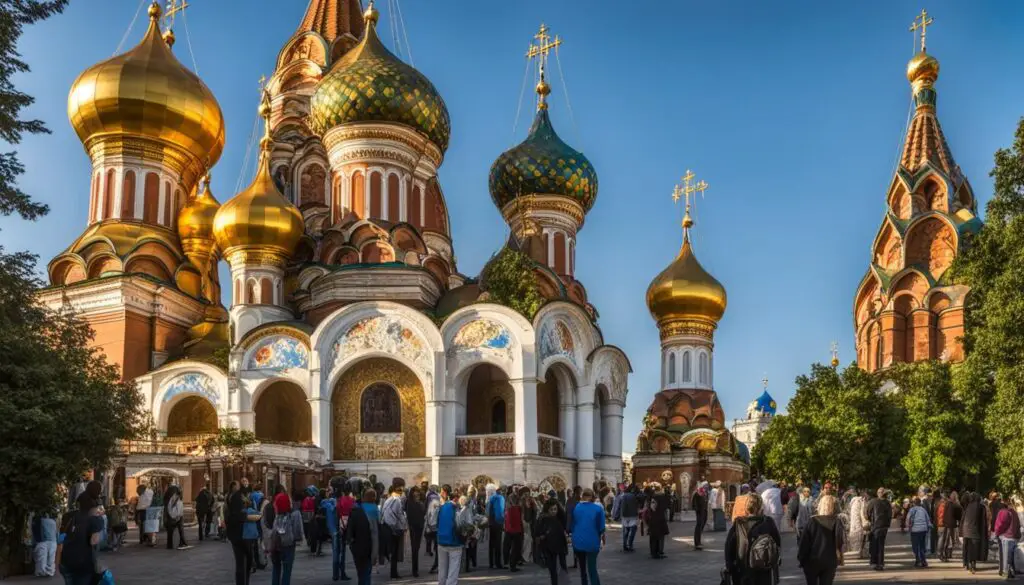
The transfer of the religious authority of the Russian Orthodox Church from Kiev to Moscow was a significant event in its history. As Kiev declined in power, Moscow emerged as the new center for Russian Orthodoxy. The move represented a shift in the balance of power within the church, with Moscow asserting its independence from Constantinople and establishing itself as the rightful successor to the Byzantine Empire.
“The Transfer of the See to Moscow marked the beginning of the Moscow Patriarchate and the church’s claim to be the legitimate heir to the legacy of Constantinople. It was a defining moment in the history of the Russian Orthodox Church.” – Archbishop Hilarion Alfeyev
Relationship with the State and the Mongol Rule
During the period of Mongol rule, the Russian Orthodox Church experienced a unique relationship with the state, which played a significant role in shaping its development and influence. This relationship was marked by a symbiotic connection, often referred to as a “symphony,” between the church and the ruling Mongol Khanate.
Under Mongol rule, the Russian Orthodox Church enjoyed special privileges and protection. The church’s properties were exempt from taxes, allowing it to maintain its wealth and resources. Furthermore, the church was guaranteed freedom from persecution, enabling it to practice and spread its doctrines without hindrance.
The Mongols recognized the importance of the church as an institution of stability and faith. They allowed the church to retain its lands, buildings, and religious authority, in exchange for the church’s prayers and blessings for the Khan and his reign. This mutually beneficial relationship ensured the church’s survival and continuity during a tumultuous period of foreign domination.
“The church, by virtue of its divine calling, consecrated not only the Tsars but also the Horde rulers, which helped to legitimize the Mongols’ authority in the eyes of the Christian population.”
This close association between the church and the state greatly influenced the formation of the concept of Moscow as the Third Rome. The Moscow Metropolitan, as the highest-ranking religious figure, played a crucial role in supporting the rising power of the Moscow principality. The church, in turn, saw Moscow as the spiritual and political center of the Orthodox faith, ensuring its protection and prominence.

Reforms and Consolidation in the 15th Century
The 15th century marked a significant period of reforms and consolidation for the Russian Orthodox Church. During this time, prominent figures such as St. Sergius of Radonezh and Metropolitan Alexis played vital roles in upholding Russian identity and spirituality amidst the oppressive rule and expansion of the Tartars. Their efforts ensured the preservation of the Church and its fundamental values, which played a crucial role in the development of the nation.
Amidst these reforms, the Church of Moscow emerged as the center of both religious and political power in the region. Under the leadership of Ivan III and his successor, the influence and authority of the church continued to solidify, further strengthening its close ties with the state. The Moscow Patriarchate, with its grandeur and significance, became a symbol of Russian Orthodoxy, protecting and propagating the faith.
“The Russian Orthodox Church, through its reforms and consolidation efforts, not only safeguarded the spiritual heritage of the Russian people but also played an instrumental role in establishing and maintaining the cultural and political sovereignty of the nation.”
To gain a comprehensive understanding of the church’s influence and stature during this period, a table showcasing key events and reforms would be beneficial:
| Events/Reforms | Significance |
|---|---|
| Leadership of St. Sergius of Radonezh | Elevated Russian spirituality and provided guidance during the Tartar oppression. |
| Role of Metropolitan Alexis | Preserved Russian identity and enhanced the influence of the Church. |
| Emergence of the Church of Moscow | Became the focal point of religious and political power in Russia. |
| Influence of Ivan III | Further solidified the Church’s ties to the state and consolidated its authority. |
This table highlights the key events and reforms that shaped the Russian Orthodox Church during the 15th century. It illustrates the crucial role played by influential figures and the consolidation of the Church’s power in Moscow. These reforms and consolidations laid the foundation for the subsequent development of the Russian Orthodox Church and its enduring significance in Russian history.
Changes and Reforms in the 16th and 17th Centuries
In the 16th and 17th centuries, the Russian Orthodox Church underwent significant changes and reforms. It was a transformative period marked by the influential role of Metropolitan Makariy and the emergence of the schismatic group known as the Old Believers.
Metropolitan Makariy played a pivotal role in emphasizing the Russian ecclesiastical tradition and promoting the power of Moscow within the Russian Orthodox Church. He sought to establish Moscow as the legitimate successor to Constantinople, solidifying its status as the spiritual and political center of the Russian Orthodox world.
During this time, the church saw itself as the “Third Rome,” aligning its identity with the legacy of the Roman and Byzantine empires. This aspiration reflected the belief that Moscow had become the rightful heir to the Christian traditions and leadership previously held by Rome and Constantinople.
However, the ecclesiastical changes and reforms introduced by Patriarch Nikon in the mid-17th century led to a schism within the Russian Orthodox Church. This schism gave rise to the Old Believers, a group that opposed the liturgical and ritualistic changes implemented by Patriarch Nikon.
The Old Believers advocated for the preservation of the traditional practices and customs of the Russian Orthodox Church, resisting the reforms that they perceived as deviating from the genuine Orthodox tradition. Their resistance to change resulted in their separation from the mainstream Orthodox Church and subsequent persecution by the state.
This period of changes and reforms both showcased the evolving nature of the Russian Orthodox Church and revealed the deep divides and tensions within its ranks. These divisions continue to influence the church’s history and shape its present-day landscape.
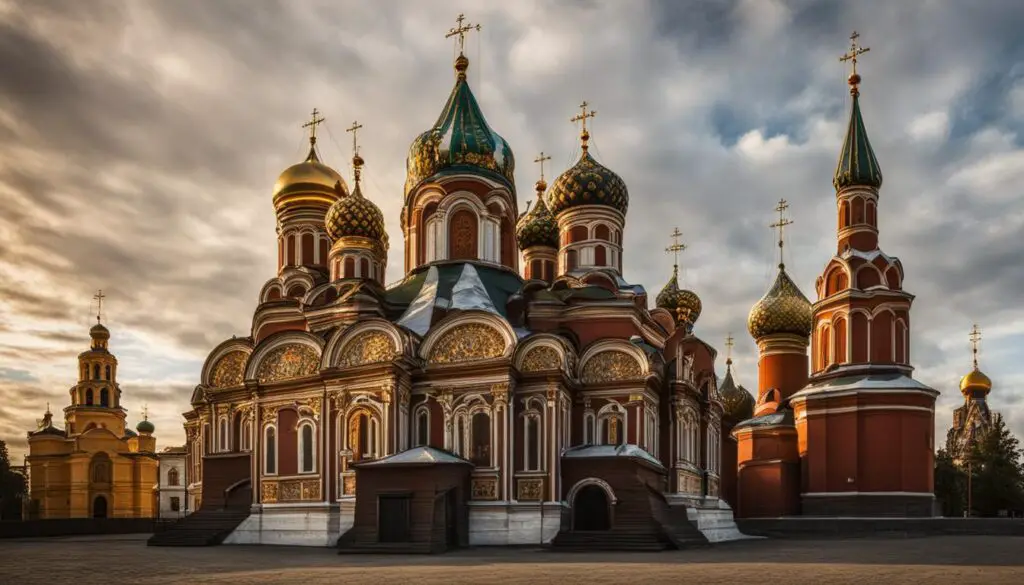
| Changes and Reforms in the 16th and 17th Centuries | |
|---|---|
| Key Figure | Metropolitan Makariy |
| Main Focus | Emphasizing Russian ecclesiastical tradition and the power of Moscow |
| Belief | Moscow as the legitimate successor to Constantinople |
| Significant Event | Establishment of the Old Believers schismatic group |
| Impact | Deep divisions within the Russian Orthodox Church, shaping its future trajectory |
Relationship with the State and the Soviet Era
In the early 18th century, Tsar Peter I made significant changes to the governance of the Russian Orthodox Church. He abolished the patriarchate and replaced it with the Holy Governing Synod, a state-controlled organization that wielded tight control over the church’s administration and decision-making process.
Under the leadership of K.P. Pobedonostsev in the late 19th century, the control over the church by the state, particularly by the conservative forces, became even stronger. This period marked a challenging time for the church, as it faced persecution and harsh restrictions under the Soviet government.
During the Soviet era, many churches were forcibly destroyed, and numerous clergy members were arrested and executed. The state aimed to eradicate religion and suppress the influence of the Russian Orthodox Church. However, even in the face of adversity, the church found ways to endure and maintain its spiritual presence.
“The strength of faith is often tested in times of hardship and persecution. In the Soviet era, the Russian Orthodox Church faced immense challenges, but it never lost hope. The faith of its members remained resilient, and the church continued to inspire and provide solace to those who sought spiritual guidance.”
In the 1940s and 1950s, there was a resurgence of the church, with a gradual easing of restrictions. However, under the leadership of Khrushchev and Brezhnev, the church faced renewed persecution. Churches were again closed, and clergy members faced imprisonment.
Despite these challenges, the Russian Orthodox Church persevered through faith and determination, preserving its spiritual traditions and offering strength and comfort to its members.

Persecution and Revival of the Russian Orthodox Church during the Soviet Era
| Time Period | Events |
|---|---|
| Early 18th century | Abolition of the patriarchate; establishment of the Holy Governing Synod |
| Late 19th century | Increase in state control over the church under K.P. Pobedonostsev |
| 1920s – 1930s | Intensification of persecution; closure of churches and arrest of clergy members |
| 1940s – 1950s | Resurgence of the church; gradual easing of restrictions |
| 1950s – 1960s | Renewed persecution under Khrushchev and Brezhnev |
| 1980s – 1990s | Revival and growth of the church; return of seized properties |
The image above illustrates the Russian Orthodox Church during the Soviet era, a time of persecution and hardships for the church.
Revival and Reunification in the Late 20th Century
In the late 20th century, the Russian Orthodox Church witnessed a remarkable revival, reclaiming its spiritual and cultural influence. After years of suppression under the Soviet government, many churches that had been seized were returned to the Church, symbolizing the resurgence of the Russian Orthodox faith.
Following the collapse of the Soviet Union in 1991, the Church experienced further progress towards its revitalization. The newfound freedom allowed for a cultural and spiritual reawakening of Russia, with the Russian Orthodox Church playing a central role in this revival.
Additionally, efforts were made to reunite with churches that had been separated. One significant example is the reunion with the Russian Orthodox Church Outside of Russia, which had existed in exile since the Russian Revolution. This reunification marked a significant milestone in the Church’s history, fostering unity among diverse Orthodox communities.
Through its revival and reunification, the Russian Orthodox Church reestablished itself as a pillar of faith, culture, and unity in Russia, reaffirming its vital role in shaping the nation’s spiritual landscape. The Church’s endurance and resilience have proven that even in the face of adversity, the flame of the Russian Orthodox spirit burns brightly.
| Revival and Reunification in the Late 20th Century |
|---|
| Key Developments |
| 1. Return of churches previously seized by the Soviet government |
| 2. Cultural and spiritual revival following the collapse of the Soviet Union |
| 3. Reunification with the Russian Orthodox Church Outside of Russia |
| Impact |
| – Restoration of the Church’s spiritual and cultural influence |
| – Continuation of the Church’s role in shaping Russian identity |
| – Strengthened unity among diverse Orthodox communities |
Contemporary Challenges and Issues
The Russian Orthodox Church, with its rich history and tradition, continues to grapple with a range of challenges and issues in the modern era. From political tensions to internal debates, the church navigates a rapidly changing society while providing spiritual guidance and addressing social concerns.
Political Tensions
The Russian Orthodox Church faces unique political challenges, particularly in its relationship with Ukraine and the Ecumenical Patriarchate of Constantinople. The ongoing conflict between Russia and Ukraine has brought about divisions within the church, as both countries lay claim to the historical and spiritual legacy of the Russian Orthodox Church. Additionally, tensions with the Ecumenical Patriarchate of Constantinople have arisen due to disputes over jurisdiction and the granting of autocephaly to certain Orthodox churches.
Internal Debates
Within the Russian Orthodox Church, there are ongoing debates and divisions on social issues and modernization. These debates reflect the diverse perspectives within the church and highlight the challenges of balancing tradition with the changing needs and values of society. Topics such as women’s role in the church, LGBTQ+ rights, and the adaptation of religious practices in a technologically interconnected world are all subjects of internal discourse.
Community and Outreach
Despite the challenges it faces, the Russian Orthodox Church remains dedicated to community and outreach efforts. The church actively addresses social issues through charitable initiatives, providing support for the vulnerable and disadvantaged. It also plays a pivotal role in the spiritual guidance of its members, offering solace and guidance in a society that is in constant flux.
Contemporary Challenges and Issues
| Challenge | Description |
|---|---|
| Political Tensions | The Russian Orthodox Church faces political tensions, particularly with Ukraine and the Ecumenical Patriarchate of Constantinople, impacting its relationships and influence. |
| Internal Debates | Debates within the church on social issues and modernization reveal divisions and the struggle to balance tradition with societal changes. |
| Community and Outreach | The Russian Orthodox Church plays an active role in addressing social issues and providing spiritual guidance within the community. |
Beliefs, Sacraments, and Worship Practices
The Russian Orthodox Church follows the Eastern Orthodox theology and worship practices. At the core of its beliefs is a firm conviction in the Holy Trinity, which consists of God the Father, God the Son (Jesus Christ), and God the Holy Spirit. The church teaches that Jesus Christ is both fully divine and fully human, and that through His sacrifice and resurrection, humanity can attain salvation.
A fundamental aspect of Russian Orthodox beliefs is the intercession of saints. Orthodox Christians believe that saints, who are regarded as righteous individuals, can intercede on behalf of believers and pray for their needs and well-being.
Sacraments and rituals hold a central place in Russian Orthodox worship. Baptism is the sacrament of initiation into the church, symbolizing spiritual rebirth and cleansing from sin. The Eucharist, also known as the Divine Liturgy, is the central act of worship. It involves the consecration and distribution of bread and wine, which are believed to transform into the body and blood of Christ.
Confession is an important sacrament in which believers confess their sins to a priest and receive absolution. Marriage is also seen as a sacrament, symbolizing the spiritual union of two individuals.
The Russian Orthodox Church conducts worship services in Church Slavonic, a liturgical language that adds a sense of reverence and continuity to the prayers and rituals. The worship follows the Byzantine Rite, characterized by its solemnity and rich symbolism.
Icons play a significant role in Orthodox worship, serving as windows into the divine realm. Icons are sacred images of Christ, the Virgin Mary, saints, and biblical events that are venerated and serve as focal points for prayer and contemplation. The use of icons helps to create a visual and sensory connection with the divine, enhancing the worship experience.
“Icons have an exceedingly mystical character and speak directly to the soul, transcending language and culture. They are not mere decorations, but instruments of contemplation and tools for spiritual growth.”
The Divine Liturgy
The Divine Liturgy is the most important worship service in the Russian Orthodox Church. It is a solemn and mystical experience, combining scripture readings, prayers, hymns, and the distribution of the Eucharist. The Liturgy follows a structured format and is filled with symbolic gestures and rituals that invite believers into a deeper connection with God.
| Elements of the Divine Liturgy | Description |
|---|---|
| Proskomedia | The preparation of the bread and wine for the Eucharist, representing the offering of Christ’s body and blood. |
| Great Litany | A series of petitions for peace, salvation, and the needs of the church and the world. |
| Antiphons | Hymns and prayers sung in alternating choirs, expressing praise and thanksgiving to God. |
| Gospel Reading | A reading from the Gospels, proclaiming the words and teachings of Jesus Christ. |
| Anaphora | The consecration of the bread and wine, transforming them into the body and blood of Christ. |
| Lord’s Prayer | A prayer recited by the priest and congregation, expressing dependence on God’s provision and forgiveness. |
| Communion | The distribution of the Eucharist to communicants, inviting them to partake in the spiritual nourishment of Christ’s body and blood. |
Conclusion
The Russian Orthodox Church, with its rich history and deep-rooted traditions, has been an integral part of the political, cultural, and spiritual development of Russia. Despite facing numerous challenges and periods of persecution, the church has managed to endure and thrive, leaving a profound legacy.
Today, the Russian Orthodox Church continues to play a significant role in Russian society. It serves as a guardian of tradition, preserving the centuries-old beliefs and practices of the faith. With its strong leadership and dedicated clergy, the church provides spiritual guidance to its followers, offering solace and support in times of need.
Furthermore, the Russian Orthodox Church actively engages with contemporary issues and challenges. It takes part in community outreach efforts, addressing social issues and contributing to the well-being of society. Through its commitment to faith and service, the church remains relevant in a rapidly changing world.
FAQ
What is the history of the Russian Orthodox Church?
The Russian Orthodox Church, also known as the Moscow Patriarchate, was founded by Apostle Andrew and gained prominence with the baptism of Grand Prince Vladimir of Kiev in 988. It became effectively independent from the Patriarchate of Constantinople in the 15th century and saw Moscow as the Third Rome with the Metropolitan of Moscow as its head.
How did the Russian Orthodox Church originate?
The Russian Orthodox Church traces its origins to the Christianization of Kievan Rus’ in the 9th century, when Greek missionaries introduced Christianity to the region. Princess Olga of Kiev was the first ruler to convert, and the church initially fell under the jurisdiction of the Ecumenical Patriarchate of Constantinople.
When did the Russian Orthodox Church become independent?
The Russian Orthodox Church became effectively independent from Constantinople in 1448 when it elected its own Metropolitan without approval from the patriarch. This marked the beginning of the Moscow Patriarchate, which saw itself as the legitimate successor to Constantinople after its fall to the Ottoman Turks in 1453.
How did the Russian Orthodox Church maintain its relationship with the state under Mongol rule?
Under Mongol rule, the Russian Orthodox Church enjoyed special privileges and protection. The church’s properties were exempt from taxes, and it was guaranteed freedom from persecution. The church and state worked in harmony, with the church supporting the rising power of the Moscow principality, which contributed to the formation of the idea of Moscow as the Third Rome.
What reforms and changes occurred in the 15th century for the Russian Orthodox Church?
The 15th century was a period of reforms and consolidation for the Russian Orthodox Church. Figures like St. Sergius of Radonezh and Metropolitan Alexis played crucial roles in preserving Russian identity and spirituality during the Tartar oppression and expansion. The Church of Moscow emerged as the center of religious and political power in the region.
What changes and reforms took place in the 16th and 17th centuries?
In the 16th and 17th centuries, the Russian Orthodox Church underwent significant changes and reforms. Metropolitan Makariy emphasized the Russian ecclesiastical tradition and the power of Moscow. The church saw itself as the legitimate successor to Constantinople, but a schism occurred with the establishment of the Old Believers, who opposed the reforms introduced by Patriarch Nikon.
How did the Russian Orthodox Church fare during the Soviet era?
In the early 18th century, Tsar Peter I abolished the patriarchate and replaced it with the Holy Governing Synod, a state-controlled organization. The church faced persecution and restrictions under the Soviet government, with many churches being destroyed, and clergy members being arrested and executed. However, there was a resurgence of the church in the later years and a renewed role in the cultural and spiritual revival of Russia.
When did the Russian Orthodox Church experience a revival and reunification?
The late 20th century saw a revival of the Russian Orthodox Church. Churches that had been seized by the Soviet government were returned, and the church regained its spiritual and cultural influence. Reunification efforts were made with churches that had been separated, including the Russian Orthodox Church Outside of Russia.
What challenges does the Russian Orthodox Church face in the contemporary world?
The Russian Orthodox Church faces challenges and issues in the contemporary world. It must navigate political tensions, address internal debates on social issues and modernization, and play a role in community outreach efforts. Despite these challenges, it continues to preserve tradition, provide spiritual guidance, and address contemporary issues in Russian society.
What are the beliefs, sacraments, and worship practices followed by the Russian Orthodox Church?
The Russian Orthodox Church follows the Eastern Orthodox theology and worship practices. It believes in the Holy Trinity, the divinity of Christ, and the intercession of saints. Sacraments and rituals, such as baptism, the Eucharist, confession, and marriage, are integral parts of Orthodox worship. The Liturgy is conducted in Church Slavonic and follows the Byzantine Rite, with icons playing a significant role in Orthodox worship.
What is the significance of the Russian Orthodox Church in history?
The Russian Orthodox Church has a rich and complex history, deeply intertwined with the political, cultural, and spiritual development of Russia. Despite facing challenges and persecution throughout its history, it has experienced periods of revival and growth. The church continues to play a significant role in Russian society, preserving tradition, providing spiritual guidance, and addressing contemporary issues.

